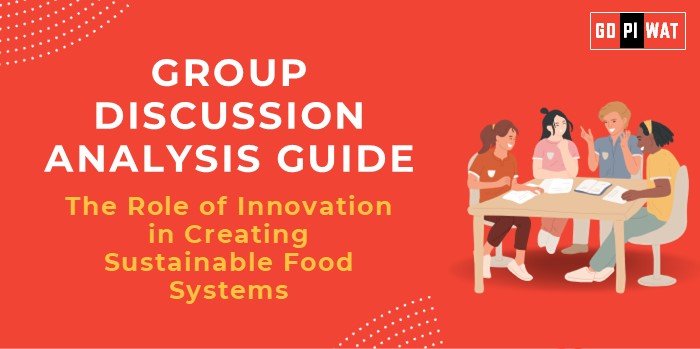🌾 Group Discussion (GD) Analysis Guide
Introduction to The Role of Innovation in Creating Sustainable Food Systems
Opening Context: As the global population heads toward 10 billion by 2050, innovation becomes essential to ensuring sustainable food systems. Climate change, resource constraints, and food insecurity highlight the urgency of this transformation.
Topic Background: Sustainable food systems aim to provide sufficient, nutritious food without depleting natural resources or causing environmental damage. Innovations, such as precision agriculture, plant-based proteins, and food waste reduction technologies, are redefining this sector.
🌍 Quick Facts and Key Statistics
- 🌎 Global Food Waste: 931 million tons annually—nearly 17% of global food production is wasted (FAO, 2023).
- 🌱 Agricultural Emissions: Account for 31% of global greenhouse gas emissions (UNEP, 2023).
- 🚜 Precision Farming Adoption: Increases crop yields by up to 20% while reducing water and fertilizer use by 15% (McKinsey, 2024).
- 🍔 Alternative Proteins Market: Projected to reach $290 billion by 2035 (BCG, 2023).
🤝 Stakeholders and Their Roles
- Governments: Policy frameworks for sustainable practices and subsidies for green technologies.
- Private Sector: Investment in R&D for innovations like lab-grown meat and climate-resilient crops.
- Farmers and Producers: Adoption of sustainable practices and technologies.
- NGOs and Academia: Advocacy, research, and education on sustainable farming techniques.
🏆 Achievements and Challenges
Achievements:
- Adoption of vertical farming in urban centers has increased food output by 300% per square foot.
- Reduction of greenhouse gas emissions through bio-based fertilizers and methane-reducing feed additives.
- Innovations in supply chain optimization reduce food waste by 40%.
Challenges:
- High costs of adopting advanced technologies, especially in developing regions.
- Limited access to financing and knowledge for smallholder farmers.
- Lack of global coordination on sustainable agricultural practices.
📊 Structured Arguments for Discussion
- Supporting Stance: “Innovation in agri-tech is pivotal to feeding the world sustainably without exhausting finite resources.”
- Opposing Stance: “Over-reliance on technology could marginalize traditional farming communities and increase inequality.”
- Balanced Perspective: “While innovations are crucial, they must be implemented inclusively, addressing socio-economic and environmental concerns.”
💡 Effective Discussion Approaches
- Opening Approaches:
- Start with impactful statistics about food waste or emissions.
- Share an example of a successful innovation, like Singapore’s agri-tech parks.
- Counter-Argument Handling:
- Highlight equitable technology access as a shared global responsibility.
- Propose partnerships between governments and tech firms for subsidies.
🔍 Strategic Analysis of Strengths and Weaknesses
- Strengths: Increased efficiency, waste reduction, scalability of technologies.
- Weaknesses: High costs, limited smallholder adoption, technological dependence.
- Opportunities: Global market for plant-based foods, AI in agriculture.
- Threats: Climate change acceleration, resistance from traditional sectors.
🏫 Connecting with B-School Applications
- Real-World Applications: Innovating supply chain logistics, reducing operational carbon footprints.
- Sample Questions:
- “What role does technology play in achieving food security goals?”
- “Discuss the sustainability impact of vertical farming compared to traditional methods.”
- Insights for B-School Students:
- Explore food tech startups during internships.
- Analyze agricultural innovation in supply chain case studies.


